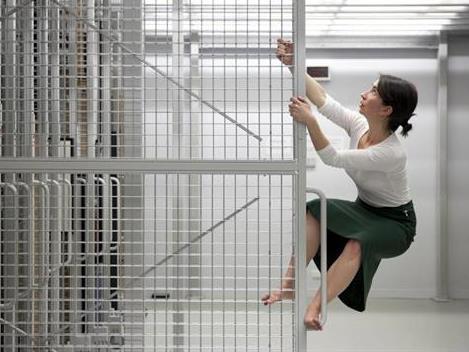Image: Untitled (Decanted rack) 2013 by Clare Rae, featuring in Melbourne Now. source: www.ngv.vic.gov.au
I had another life before becoming an arts journalist. That is not unusual. Most people who work in the arts can say the same, having moonlighted in other professions, hopscotched across the sector, and moved between the minors to the majors.
This is why arts professionals are so valuable – they have a bag brimming with incredibly niche collected knowledge. Such as how to clean a milkstone by Wolfgang Liab, source ants for a Yukinori Yanagi installation, or drain a formaldehyde tank by Damien Hirst.
Skills that I now use daily as an arts journalist… Well, I am writing about it, yes?
Having worked in a regional gallery, a commercial gallery, for a biennale and a self-managed ARI, these are some of the lessons – and the secrets – I can share.
The list:
1. The person at the front desk is not dumb or merely glamorous; they usually hold one or two degrees.
2. The invigilators – or security guards – love to have a chat about the work.
3. You can’t always pick a collector. Big lesson learned when working in a San Francisco gallery during the dot-com boom of the late 1990s – the Okanui pockets can also be very deep.
4. A pocket level is your best friend. The size of a pencil and bought for around a dollar, it offers a quick check whether a work is straight.
5. The LED level is even better. If there is one tool you invest in make it the LED level – its glowing red line makes a perfect hang much easier.
6. People never stay in a video installation for the full length of the piece. TIP – keep ‘em short guys.
7. The art museum or gallery is the cathedral of invisible labour. So much unseen work goes into those white walls.
8. Most installers are practising artists.
9. The registrar is probably the most misunderstood staffer but holds the essential cross-department role in a museum. They record and manage the movement and storage of all art works.
10. Vinyl wall text can also be artwork. Mmmmm, confusing sometimes.
11. The majority of daily visitors to an art gallery are first time visitors.
12. Galleries hate backpacks.
13. People take a photo on their phone or look at the wall text first. Then, they might, look at the artwork. People are obsessed with the art selfie.
14. Traditionally, the label for a work of art is hung to the right hand side of an artwork.
15. Art galleries usually have great cafes and restaurants with good coffee.
16. The director of a gallery is not unapproachable – just insanely busy.
17. Figurative and narrative work is much easier to sell than abstract or conceptual work.
18. The role of entertainment is increasingly a curatorial consideration.
19. Didactics is the fancy word for wall information.
20. A cardboard collar is a good cheap trick to protect the face of a painting when stacked in storage. Simply, staple strips to the side of the stretcher to create a guard.
21. In a commercial gallery, most of the selling work with clients is done before the exhibition opens – or has nothing to do with the exhibition at all.
22. Artists are terrible at editing their work for an exhibition. Don’t overhang and trust the gallerist.
23. Blue paintings sell better than red paintings (except in China); and yellow paintings are a real struggle everywhere.
24. Many museums run great free film programs. Who needs to pay $20 at the cinema when you can get quality films, and look at art?
25. The standard gallery commission is 50%.
26. People want to read something – and they usually take it with them. Always present a short blurb on the work.
27. A lot of small damage occurs to art works – and is repaired – in house.
28. Wall texts are hung with blue tac. Small object are held in place with Museum Gel.
29. Art consultants buy as much as individual collectors.
30. Even when the label says don’t touch – people do.




